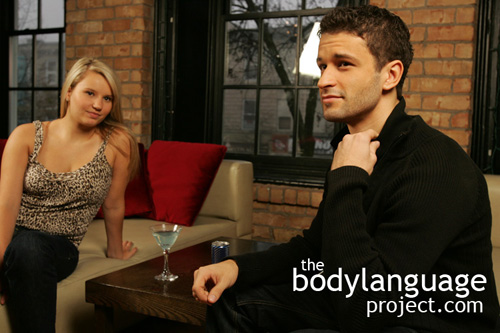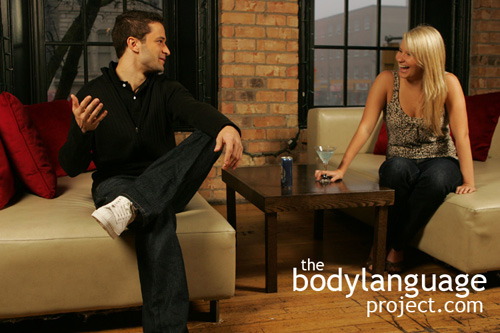In this third chapter we examined and compared the various influences on body language: genetic, learned and cultural. We found that in terms of genetics we all show similar roots and so display similarly across cultures, but that learning does play a role in how we might signal. We also covered emblems, illustrators, affect displays, adaptors and regulators which all form a part of what is called kinesics or how nonverbal behaviour relates to movement. Emblems, we found, are quotable gestures that are culturally specific which can be used as replacement for words and have a direct verbal translation. Illustrators are a second type of gesture that we use while speaking to help us paint a more descriptive picture such as talking about a boxing match and using a punching motion. Affect displays is nonverbal language that reveal our emotional state such as smiling or frowning and adaptors are movements or gestures that are used to manage our feelings or control our responses such as postural changes. Sometimes these adaptors have hidden meaning, but other times they do not, so caution is warranted. Regulators on the other hand control turn taking and flow when people speak with one another. Finally we covered high and low context cultures as it relates to touching and the ways various cultures meet and greet one another.
Tag Archive for Gestures
Some Gestures Are Universal
by Chris Site Author • March 5, 2013 • 0 Comments
Smiles which signify submission and enjoyment to others are a great example of a universal expression. As mentioned not all gestures, however, have a universal origin, but one that does is the shoulder shrug. The shrug is done by bringing the shoulders up, drawing the head in, and turning the palms upwards so as to reveal that nothing is hidden. The shoulder shrug can also demonstrate submission or that what is being said isn’t understood as in “I don’t know” or “I don’t get it”. Pointing finds its place all over the world to indicate direction or to emphasis a point. However, even the pointing gesture shows variation across culture as some will point with the index finger, others will use the middle finger and yet others still will point with a closed fist and use the thumb to indicate. Most cultures find pointing rude altogether, but others are more tolerant of its use. Where the middle finger is seen as a rude gesture, using it to point can be extremely off-putting and should be avoided.
Another gesture that has roots in various cultures is the beckoning signal whereby the index finger is curled upwards repetitively, with the palm facing up and the remaining fingers clenched. It means “come here”. In Africa and Spanish speaking countries the entire hand can be used and includes all four fingers whereas in Sicily the entire hand is waved palm down in a sweeping motion as if to drag the person in. The Japanese have a similar gesture, but the four fingers are used with the palm facing the target and is placed at head height. The fingers are then pulled inward toward the palm. To Americans and Europeans, it might be confused with waving rather than beckoning primarily due to the height of the hand. This gesture is found in the Maneki Neko which is the “beckoning cat” a symbolic figure. The beckoning cat also translates to the welcoming cat, lucky cat, money cat or fortune cat.
Most gestures, however, are heavily culturally driven and are therefore learned. They are transferred through time by their use. Gestures are obvious to locals, but to visitors the gestures often means something else altogether. With globalization and ubiquitous media the nonverbal gap is shrinking all the time. If the trend continues gestures will become more and more universal. As regional medias become more uniform, so too does the body language. Even a country kid knows how to act in a congested downtown city core from what they’ve seen in movies and on television. Even isolated rural cultures including native tribes, absent of modern media are seeing more and more visitors via tourism every year serving to assimilate their gestures.
Regulators, Regulate Speech
by Chris Site Author • March 5, 2013 • 0 Comments
The final type of gestures are called regulators because they are used to modulate and maintain the flow of the speech during conversation. Essentially, we use regulators to control turn-taking in conversation and they can take the form of kinesic such as head nods or nonkinesic such as eye movements. Regulators are different across cultures more so than any other element of body language discussed thus far.
In a study by Marjorie Vargas in 1986, it was noted that black students in the United States felt insulted by the white educators. The educators weren’t picking up on cues that the students understood what was being instructed. For example, the white students would nod and murmur “uh-huh” but the black students would nod much less and use “mhm” instead. The teachers took this to mean that the students didn’t fully understand the material, but this wasn’t so, they just expressed their understanding differently.
In Japan, the up and down nod of the head or “yes motion” is utilized not to show ‘agreement’ but to show ‘understanding’. Therefore, while pitching a new idea or venture, it would be foolish to think that the continuous head nodding by the Japanese was do to their willingness to invest. Creating a simple dos and don’ts list is not feasible for these nonverbal kinesics in speech for the simple fact that there are far too many to list and the variation of meaning across culture is so varied. With the simple awareness of emblems, illustrators, affect displays, adaptors and regulators the incidence of misinterpreting their meaning can be reduced.
Caution is therefore important when dealing with international business so as to avoid any harm in interpretation. Some other examples of regulators include putting the hand up to signal that you are ready to speak, putting the finger up to the mouth to bring silence, waiving the hand around in a circle so as to speed things up, rolling of the eyes showing disapproval, a gasp to show shock, throwing the hand to someone to include them in the conversation, or shaking the head disapprovingly. All these gestures control the flow and pattern of speech by directing, disapproving, speeding things up or slowing them down, and even cutting the speaker short.
Using regulators in speech is necessary to create seamless turn-taking and to avoid appearing rude, dominating or frustrating the people you are talking with. It prevents having to interrupt, eases the flow of speech and allows everyone to make the points they wish to make without having to cut each other off mid-sentence. The net effect of a good conversation is connectivity through the creation of seamless turn-taking.
Adaptors
by Chris Site Author • March 5, 2013 • 0 Comments
Adaptors are movements or gestures that are used to manage our feelings or control our responses. Adaptors include movements done to improve comfort or reduce stress and often happen at such a low level they usually escape awareness. Adaptors include movements such as shifting in a chair or postural changes, crossing the legs, pulling at a shirt collar, adjusting a tie, loosening clothing and so forth.
What is interesting to researchers is that some adaptors serve a real purpose and others indicate stress. For example, sometimes our pants really are uncomfortable so we scratch our legs, other times the stress from outside pressure causes us to scratch in an effort to displace energy and distract us. Crossing the legs toward your date might be read as an indicator of interest, but might instead serve to alleviate numbness from loss of circulation. Children will rub their eyes repeatedly when tired, but this is not because they become itchy!
Scratching the nose is another example of an adaptor and could be misread as an indicator of a lying or might actually serve to relieve an itch. Another common adaptor used by adults is the head-grooming gesture where the hand messages the back of the neck or head to relive stress. This gesture is not an authentic gesture motivated by a physical purpose. Rather it used as a method to achieve comfort when facing discomfort applied from the outside. Just about every cue related to body language can be an adaptor. Arm crossing, leg crossing, scratching, fidgeting, twitching, rubbing the eyes, and so on, are all part of the human repertoire and not all have hidden meaning all of the time.
It is the job of the body language reader to decide which movements are motivated by a real physical purpose and which are motivated by an underlying emotional purpose. Usually stress release methods are person specific so once they are detected can be reliable as predictors in future encounters. Some might pull an ear lobe, rub one’s throat, pull on a collar or scratch the back of the hands. I will say that it’s usually pretty obvious when a gesture like scratching is real because it is targeted, quick, non-repetitive and provides instant relief, but when it’s as a response to emotional trauma, it show opposite characteristics. It is general in nature, perpetual, repetitive and provides no discernable relief (at least not instantaneously). The context, meaning high or low stress environment provides strong clues to the purpose of the adaptors. All proper body language reads should take context into consideration.
As we see, movements or adaptors come in two forms. They either have hidden meaning, or they do not. Plenty of emphasis has been given by researchers on these subconscious clues on the grounds that they would unlock secrets. However, the importance placed on adaptors is probably overstated and oversimplified. The real goal of the body language reader is to decipher the difference between adaptors with no meaning and movements and gestures that have actual meaning. Adaptors in cross-cultural meetings can also be potential landmines. For example, emblems, specifically because they are culturally engrained, are emitted without conscious thought. Many Arabic countries see the sole of the foot or the figure-four-leg cross as offensive and rude (an emblem of sorts to them) so they may classify a Westerner as something they intent not to be. It is clear to the Westerner that they wish only to take up a more comfortable seating position. The take-away message is to treat adaptors with the care they deserve instead of jumping to inaccurate, embarrassing or even disastrous conclusions.
Affect Or Emotional Displays
by Chris Site Author • March 5, 2013 • 0 Comments
Affect displays is subset of nonverbal language that reveal our emotional state. For example, if we are happy we can show enthusiasm, or if we are telling a sad story, we correspondingly show somber. Affect display include facial expressions such as smiling, laughing, crying or frowning.
Awareness of various kinds of affect and how it is used in speech will provide vital clues about the speaker and his or her intent. Affect displays occur in synchrony and within the rhythm of speech. They emphases certain words or phrases and are an integral part of speech and thought. They can tell us about the expressiveness of a person and also what they find most important in their speech by which words they choose to emphasize. Posture can also signal emotion as can a variety of other gestures.
Affect is also different from culture to culture. For example, Russians tend to smile much less than Americans and therefore an American might come across as overly friendly to a Russian. Conversely Russians might come across as disinterested or aloof to Americans because they smile less frequently. In reality, both cultures are neither aloof nor overtly content, they simply appear to be so as they are viewed through a complimentary cultural norm bias. There is no right or wrong way to display affect, which is to say that no culture is better or worse because it smiles, frowns or cries less or more than another during expression.
Emblems: Word Replacement Gestures
by Chris Site Author • March 5, 2013 • 0 Comments

Peace or victory? Depends on your audience! Some gestures can be seen as offensive in different cultures.
Emblems or “quotable gestures” are those gestures that are culturally specific which can be used as replacement for words. That is, the gestures have a direct verbal translation. Obviously these gestures will mean different things in different settings and can range from complimentary to offensive. Studies show us that people lower in socioeconomic status gesticulate, which is the action of using gestures while talking, more often than those with higher status. Usually this is tied directly to education, and those who have a higher level of schooling also have a larger vocabulary so instead of using gestures to express themselves, they use words instead.
The middle finger is an obvious gesture to Westerners and so too is the peace sign (or V-sign) which can also mean victory. However, George Bush senior was famously ridiculed for “flipping” the V-sign as he was met with Australian onlookers. In their culture the same gesture is considered an insult. The V-sign where the palm faces outward has long been an gesture meant to insult but not just in Australia, also in England and the rest of the United Kingdom, Ireland and parts of France.
The “hook ’em horns” where the index finger and little finger are extended and the remaining fingers held down with the thumb is poplar to University of Texas Longhorn fans, but when directed to a married Italian man, means that his wife is having an affair. In North America, the “thumbs-up” gestures can mean “great” or “I need a ride” but for Greeks the gestures means “up yours” and is accompanied by a rapid upward and slower downward motion. Another gesture that has multiple cultural meaning is the “OK” sign where the thumb and index finger come together to make an “O” shape with the remaining fingers flared out. In Western cultures this means that things are “A-OK” but in Russia or Turkey, it describes a sexual insult, specifically identifying an orifice. These select few emblems illustrate the importance of cultural context when it comes to gesturing. Since the signals have a direct verbal translation that varies from region to region, it is paramount when one travels, to make note of these differences to avoid a potentially damaging misunderstanding.
Emblems, Illustrators, Affect Displays, Adaptors And Regulators
by Chris Site Author • March 5, 2013 • 0 Comments
Gestures are used in speech to convey information more efficiently or to express attitudes or emotions and as a body language reader they give us clues as to the speakers mental framework from which they speak. Beneficial byproducts of gestures include making speech occur more smoothly and increased liking between speakers and listeners. In the following section we will cover “kinesics” which is the subclass of nonverbal body language that is related to movement. Kinesics is probably the most talked about and most common type of body language but also the most easily confused cross-culturally.
The first full length study on gesture was published in 1644 by John Bulwer. He catalogued dozens of gestures and produced a guide on how to increase clarity and eloquence in public speaking. Further research has shown that some gestures are universal and therefore have ubiquitous meaning across cultures, while others only have local meaning. Other gestures are context specific so mean one thing in one place and can mean something entirely different elsewhere. Pointing, made by extending the index finger and balling up the rest of the hand for example, is one of the gestures that has the same meaning everywhere, but the okay-sign made by touching the index finger to the thumb and flaring out the remaining fingers, as we shall see later, does not.
Some cultures also tend to gesture, called “gesticulation” when used in speech, more or less often than others. For example, Italians are known to use a lot of gestures in speech whereas the English tend to use gestures infrequently. The English culture, on the other hand, deems high rates of gesticulation as being impolite. The high gesture cultures include Hebrew, French and Spanish.
The more social way for us to use our hands is to use them in concert with what is being said, although taken to extremes like the Italians, or lack thereof like the English, can be counterproductive. A balance between the two, will be the best case. The hands and arms add to the dialogue and liven it. Keeping your hands to your sides or your arms crossed tightly might be comfortable, but those that use their hands moderately while speaking appear intelligent and honest when viewed by others. Universally, closed posture come off as negative and anti-social no matter what kinds of truths spoken or positive feelings intended by the speaker. This is why it’s so important to be conscious of our gestures because even if we aren’t, others will be. Whether or not others bring closed body language to consciousness, is not relevant. Our impressions are created in others passively with no active thinking.
The various gestures have been broken down into five categories: emblems, illustrators, affect displays, regulators which we cover next.
Introduction – Chapter 3
by Chris Site Author • March 5, 2013 • 0 Comments
If you spend time traveling or do business in more than one country then this chapter will prove invaluable. Not all body language happens the same way all over the world. To some this revelation gives them ammunition against body language because they say that since it is not totally universal, it is not innate and therefore not predictive, however this is not so. While some body language crosses culture, other language does not, what is important though, it to know which is which. We will spend the following chapter looking at how body language varies from region to region and hence from culture to culture and you will see that some body language is learned while some innate or genetic.
As we progress we will look at how emblems, illustrators, affect displays, adaptors and regulators add colour to our language and as how to use them. We will also discuss how these facets of body language vary across regions. The two take-away messages from this chapter is that it is the sender that determines the accuracy of the message no matter what the culture, and that it is up to you to decide what it means, and that it is the culture in which we find ourselves which dictates what’s normal. In this context, normal is what tells us how we should comport ourselves. We will see that our innate body language dictates our culture, that some gestures are universal (and some are not) and that touching preferences and desire (or tolerance) to closeness is learned. Finally we will cover the ways in which cultures meet and greet one-another.
Emulating Alpha’s Body Language
by Chris Site Author • March 5, 2013 • 0 Comments
Gregory Hartley author of I can read you like a book talks at length about how we are constantly at the whim of ‘Alpha’. As he states it we are either creating the social norms or we are following them. Think about this in terms of your work place and about who calls the shots. Is your body language free flowing or does it react to that of your boss and managers? Do you sit like you do at home? Is your body language relaxed? How does it change when you move from your private space, your cubicle, or your office? How does it react when you are being reprimanded? I suspect that more then you know Alpha’s, not just in your workplace, but in your environment at large and plays a big part in how you comport yourself. Hartleys says that “Unless we are alpha, we are emulating the alpha and overlaying it to our own catalogue of gestures to maintain identity while keeping alpha happy.”
He divides us further into three categories. They are sub-typical, typical and super-typical and places everyone on a bell curve of behaviour within a given culture. The bell curve has a shape of a bell and shows the frequencies of behaviour with most people having middle ground behaviour. The super-typical show extremities in behaviour and set the rules for our cultures and microcultures, they are the politicians and celebrities of our world. Within every sector of our lives there exists this bell curve of behaviour because each of the groups we belong to has a set of acceptable behaviour; at work, your social network, at school and so forth.
Think of the playground, where the super-typical are the popular kids whom everyone looks up to and the sub-typical as the losers, the rest are in the middle. We look up to the super-typical and try to be like them except in the case of the sub-typical who simply long to advance to typical. In our workplace, the super-typical are our bosses and managers, the typical are the average people and the sub-typical are those at the low end of the bell curve.
Naturally, no matter where we are, we all know who these people are because rank is part of our evolutionary history. The sub-typical are those that form part of the group but aren’t the norm and they are consistently dismissed even though everyone sees them as part of the group. In life, the sub-typical are the homeless or socially inept, they don’t take any part in creating our social norms and as mentioned our super-typicals are our politicians and celebrities. Everyone belongs to some sort of group so we all follow social norming and we all to one degree or another follow our alphas. This then triggers behaviours, actions and therefore body language which becomes typical within our groups. So next time you watch other people’s body language be sure to frame it in light of imitating alpha.
Body Language Of Children
by Chris Site Author • March 5, 2013 • 0 Comments
 Babies are almost entirely dependant on nonverbal communication in their first few months, that is, if we discount crying! As children age, they still rely, as adults do, on nonverbal language such as pointing at a toy rather then asking for it, pushing other children aside when it suites them, or even hugs to show affection and exaggerated pouting to garner sympathy. Babies as young as nine month’s old, who lack verbal language, can even begin using sign language to convey desires showing just how rooted non-verbal communication is all of us.
Babies are almost entirely dependant on nonverbal communication in their first few months, that is, if we discount crying! As children age, they still rely, as adults do, on nonverbal language such as pointing at a toy rather then asking for it, pushing other children aside when it suites them, or even hugs to show affection and exaggerated pouting to garner sympathy. Babies as young as nine month’s old, who lack verbal language, can even begin using sign language to convey desires showing just how rooted non-verbal communication is all of us.
When young children lie they often have troubles making eye contact or they might hang their head, appear tense or they might even quickly pull both hands up and cover their mouths as if to shove the lie back in from where it came from. Even some adults will perform these gestures if they let slip a secret or particularly juicy piece of gossip in the wrong circle. However, at other times, both children and adults are not as obvious. A 2002 study by Victor Talwar and Kang Lee out of the University of Queens, Canada, however, showed that children as young as three are naturally adept at controlling their nonverbal language as it applies to deception. In the study, children were able to fool most of the evaluators of their deception as a videotape showing the lie was replayed. Children are not particularly skilled at lying through verbal channels though, and they slip up easily revealing inconsistencies in their stories, so this is where you can really catch them. We will cover deceptive body language at lengths later on.
Other emotional body language emitted by children is much more prevalent. For example, children use slouching and pouting to show that they are upset and disappointed but as we age, we drop our nonverbal cues in favour of verbal expression. We naturally become more adept at repressing what our bodies do and tend to use more conscious thought and spoken words since it is more direct and less easily misinterpreted. What starts off as a quick mouth slap movement to the mouth when lying (or swearing) in children, slowly becomes a touch to the corner of the mouth. Later, restraint forces the finger to the side even further and then instead of touching the mouth it touches the side of the nose instead. As people age, they become much more difficult to read. By logical progression, the hardest to read of all are sixty-year-old politicians!
As an interesting aside, dedicated parents even claim to be able to sense when a baby is about to relieve themselves and so avoid messy diapers. This technique is referred to as elimination communication. By reading gestures such as frowning, squirming, fussing or tensing, mother’s (or fathers!) in combination with baby’s particular rhythms, can detect when potty time is immanent. Once the baby’s cues have been deciphered the mother can anticipate potty time by holding baby over the toilet and cuing with “hiss-hiss” or “wiss-wiss” sounds. To associate the hissing sounds with urination, this process must be repeated ten to twenty times each day!








